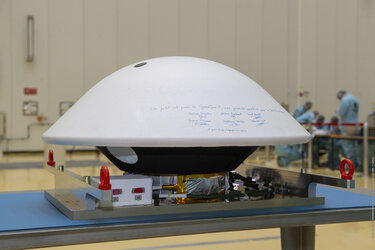

SpaceCase SCX-01 team photo
Thank you for liking
You have already liked this page, you can only like it once!
SpaceCase SC-X01 team with their reentry capsule at the payload integration facilities at Europe's Spaceport in French Guiana, 23 May 2024.
SpaceCase SC-X01 is built by ArianeGroup, the same company behind the Ariane 6 rocket that will launch it into space. Staying attached to the rocket’s upper stage for the most part of its three-hour mission, SpaceCase will detach just minutes before the upper stage deorbits and head for a fiery controlled destruction in Earth’s atmosphere.
Whereas the upper stage is designed to burn up harmlessly, SpaceCase SC-X01 is going to show off the opposite side of human engineering: survive the intense heat that builds up as spacecraft return to Earth at speeds of 28 000 km/h.
Most spacecraft designed to return to Earth use ablative materials – as the outer layer heats up it will burn off and be whisked away, taking the heat build-up away with it, and on to the next layer until splashdown.
SpaceCase SCX-01 uses the same principle but its unique selling point is that its heat-protective shield -- made of carbon resin called NAXECO® / resin – is also the structure. Whereas most spacecraft heat shields are glued or bolted on to the spacecraft structure, often in tiles, SpaceCase SCX-01’s monolithic heatshield is the structure of the capsule itself. This has many benefits from weight to simplicity and cost.
To keep costs and production time low, SpaceCase is simple by design. The innovations in this demonstrator include the shape of the capsule that could be used for a sample return from space or another planet – it will orient itself with the heatshield pointing down due to its aerodynamic shape to prove the design and test the material.
Inside SpaceCase SC-X01, avionics will be recording heatshield temperatures and trajectory data and send it to the project team via satellite. There are no parachutes on and no intention to recover the hardware – that will be for a second mission. The team plans to use plug-and-play standard dimension CubeSats inside the vehicle on next tests in the future.
-
CREDIT
ESA/ArianeGroup/Arianespace/CNES -
LICENCE
ESA Standard Licence

SpaceCase SCX-01

Working on SpaceCase SCX-01

Hoisting SpaceCase SCX-01

SpaceCase SCX-01 top

